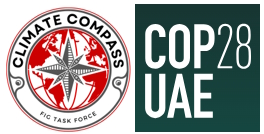

News in 2024
|

At the 28th Conference of the Parties (COP 28) in Dubai from 30 November to 13 December 2023 in Expo City, Dubai, United Arab Emirates, delegates from across the globe convened with a singular purpose - to confront the pressing challenge of climate change head-on. This pivotal gathering marked a significant milestone in global efforts to address climate change, presenting unparalleled opportunities for professionals from diverse sectors to contribute to the fight against climate change. In this article, we delve into the key highlights of COP 28 and explore the pivotal role that professionals in the geospatial and land management industry can play in shaping the global climate agenda.
One of the standout achievements of COP 28 was the historic agreement signalling the "beginning of the end" for the fossil fuel era, a critical driver of climate change. This landmark consensus, reached for the first time in almost three decades of international climate negotiations, underscores the urgent need for a swift transition to renewable energy sources and sustainable land management practices. While not directly within the realm of geospatial and land management, this transition highlights the crucial role of geomatics and geospatial data in identifying suitable locations for renewable energy infrastructure and monitoring the ecological impacts of energy transitions.
Additionally, COP 28 saw the operationalization of funding arrangements for addressing loss and damage caused by climate change. This development presents significant opportunities for geomatics, surveying and spatial information professionals to contribute to risk assessment, disaster preparedness, and post-disaster recovery efforts. Geospatial technologies can play a vital role in assessing the extent of damage caused by climate-related events and identifying vulnerable areas prone to loss and damage.
Furthermore, parties at COP 28 agreed on targets for the Global Goal on Adaptation (GGA) and its framework, highlighting the importance of adaptation planning and strategies supported by geospatial data and remote sensing technologies. Geospatial professionals can make substantial contributions to resilience-building efforts by providing spatial data for vulnerability assessments, land-use planning, and infrastructure development in climate-sensitive areas.
By emphasizing the crucial link between climate action and biodiversity conservation, COP 28 underscored the significance of conserving and restoring ecosystems. This presents unique opportunities for professionals to leverage remote sensing data for forest monitoring, biodiversity assessments, and carbon mapping. Geospatial professionals play a pivotal role in monitoring changes in land cover, deforestation rates, and carbon stocks, thereby supporting efforts to conserve natural resources and mitigate climate change.
In conclusion, COP 28 serves as a rallying call for collective action to address climate change and build resilience in the face of environmental challenges. Geospatial and land management professionals are poised to lead this charge, armed with the necessary tools and expertise to drive meaningful change. As we navigate the complexities of climate change, collaboration, innovation, and advocacy will be paramount. Together, let us rise to the challenge and seize the opportunity to create a healthier, more resilient planet for generations to come.
FIG Working Week 2024 that wil take place 19-23 May 2024 includes several sessions with a climate agenda. Read more at www.fig.net/fig2024 and register now
Read more about FIG Climate Compass Task Force
Simon Ironside and Naa Dedei Tagoe
FIG CLimate Compass Task Force members
March 2024